By Heather Lloyd, Head of Product Marketing at Nano Interactive
Eventually, the industry will lose third-party cookies in the Chrome browser. As of mid-2023, Google will join the likes of Apple and Mozilla in no longer allowing users to be tracked via cookies. It’s a change that’s going to mean a lot of different things to a lot of different people but, however it affects you, it’s going to completely transform the way we all do things.
The way we used to track return on investment (ROI) was invariably through cookies. Obviously, as cookies are disappearing, that’s not going to be possible, so we need to find different ways of understanding the effectiveness of media. Ultimately, the heavy reliance on tracking post-click conversions, or post-impression conversions, was never an ideal way of assessing the impact of our campaigns. And it’s going to be even more difficult to track those instances back to sales in the future.
Of course, we are trying to find ways around this issue; some partners are looking into probabilistic algorithms that will understand sales off the back of a small section of activity, taking into account previous conversion rates and data from when we had cookies alongside additional data sources. But, even with these alternative techniques, we’re not going to be able to track everything in the way that we used to.
Attention metrics
This is where attention comes in.
The demise of cookies was initially linked to targeting – that’s the primary way everyone was thinking about it. But, as time has gone on, people have started to realise that it’s way more than just targeting. It’s verification. It’s reporting. It’s attribution. It’s all linked to the effectiveness of a campaign. That’s why attention is a huge point of focus for the industry right now.
And, with consumers being more au fait with the value of their data, attention has the potential to deliver an understanding of effectiveness without the need for any personal information, and encourage advertisers to be more creative in the ways that they try to engage users.
Consumers are exposed to thousands of ads every day, but many of those ads will never be noticed. There’s an ad surplus, but an attention deficit. As such, advertisers need to consider if their ads are actually capturing some of that limited attention.
One way of measuring if that is the case is to look at the effectiveness of time-in-view, and how that relates to uplift on brand metrics, for example. By definition, Time-in-view means how long the creative is in view for. We are finding that a longer time-in-view increases brand uplift and, the longer a campaign has ads in view, the higher the percentage increase in brand metrics too.
Finding the right solution
Nonetheless, attention isn’t going to be the answer for everything. It will be of key importance to many campaigns but, in some cases, other metrics will still provide better outcomes. As we begin to understand attention more as an industry, we’ll start to understand which campaigns benefit most from adopting this new optimisation and measurement metric.
Reaching an agreed-upon definition of what attention is will be a key factor to reaching that understanding, but currently, that feels far off from where we are right now. However we need to make sure that whatever we land on is attainable for everyone – whether you’re a small client, whether you’re a large client with access to the biggest agencies in the world, whether you’re someone who wants to activate on their small network of sites.
Attention is one of the answers to the post-cookie world, and has the potential to work for, and benefit, all sides of the industry. We now just have to work together to define it, and we’ll all be reaping the rewards that come with that – whether you’re a consumer, brand, publisher, agency, or ad tech vendor.












